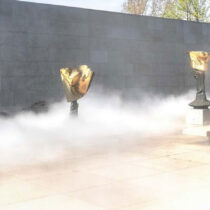Ancient Akanthos, the founding of which is mentioned in various ancient written sources, is the most important town of north-eastern Chalkidiki and a major port in the north Aegean. It owes its development to its geographic position and its mineral and forest wealth. Around 530 BC, the broad circulation of its coins – they have been found in Egypt, Sicily, Persia and elsewhere— is indicative of the commercial and financial role played by the city. Akanthos appears at the forefront of history during the Persian wars. In modern times, the earthquake of 1932 caused the abandonment of ths town, and thus a continuous habitation of at least three centuries came to an end. The systematic excavation of the ancient settlers started only in 1994 and brought to light prehistoric finds, mainly of the Bronze and Iron Age. A storage area of the Iron Age, part of the Classical-Hellenistic fortifications, extending over an area of approximately 140 acres, and remnants of a monumental temple, probably of the Classical period came to light. An important large edifice with an atrium and wall painting brings to mind houses of Pella. The finds from this building date from the Hellenistic period. Moreover, two cemeteries have been located, which in twenty years of excavational research have produced over 9,000 graves and valuable information about the everyday life and the cultural level of the inhabitants of the town.
Akanthos – Erissos – lerissos
21 Aug 2012
by Archaeology Newsroom
- A
- A
- A


